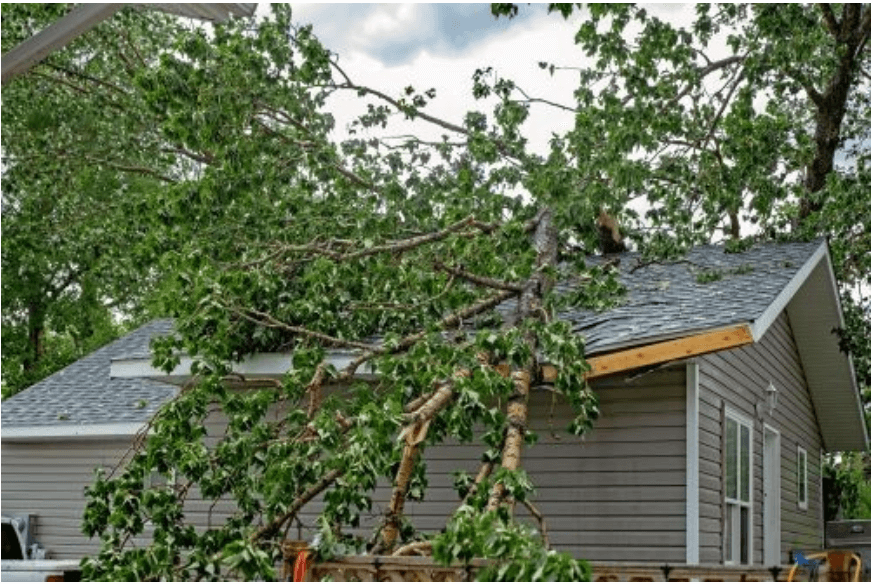Your worst fear as a homeowner came true—a tree in the yard fell. And even worse, the tree fell on the house. So what do you do next? How do you ensure everyone in the house is safe? How can you minimize the damage? And what can you do in the future to prevent this from happening again? Read on for some expert tips about how to handle a tree falling on your house.
Respond Quickly
Once the tree falls on your home, take action as immediately as you can. First, make sure your family is safe and out of the way. They may just be fine in another area of the house. But you should also make an emergency evacuation plan ahead of time just in case. Acting quickly prevents potential injuries and further damage from happening.
Immediately Call for Help If Powerlines Are Involved—Do Not Touch
While it doesn’t happen every time, trees falling on houses can cause the power to go out or to flicker on and off. If this happens in your home, the tree may have taken out your power lines. In that case, call 911 as well as your electrical company. If the power lines are down, there’s a serious risk of fire or electric shock. If you smell or see smoke, evacuate the house and call the fire department. You should also contact your gas company to see if any gas lines were damaged.
Protect the Damaged Area
A tree falling on your house may have caused broken windows and holes in the roof. To prevent further damage by severe weather conditions, especially to the interior, tape and/or cover-up as much of the damage as you can. If the damage is severe, or if it’s in a place you can’t safely reach, such as the roof, you may want to contact a contractor to do the taping.
Document the Damage
Something that may not immediately come to mind but is incredibly important, is providing proof of the damage for your insurance claim. Once you and your family are out of immediate danger, take as many photos as necessary of the damage to your house caused by the tree. You might want to take a video of it as well. If there’s damage somewhere you can’t easily or safely access, like the roof, ask the emergency response team to take some pictures for you.
Consult Your Homeowner’s Insurance
One important factor is how the tree fell on your house. If it was due to weather conditions, such as a lightning storm, blizzard, or heavy wind, it’s more likely your insurance will cover it and you’ll just have to pay the deductible. But if the tree falling was a result of something you did, it may be more complicated.
There’s also the question of who pays if your neighbor’s tree is the one on your house. Or if one of your trees fell on their house. Consumer Reports has a guide to how homeowners insurance typically responds to the different scenarios on their website. Regardless of what is and isn’t covered, you might want to consider waiting until the insurance claim is settled before making permanent home repairs.
Remove the Tree
Of course, another major problem you’ll have to face is how to take care of the tree that fell on your house. A licensed professional should handle the tree removal. Even if you DIY home projects. When you’re not an experienced tree removal expert, you’re at great risk of accidentally causing further damage in the process. And if that happens, your insurance will likely not cover it. You could also injure yourself or someone else. So instead of taking those potentially costly and dangerous chances, turn to the experts at Mr. Tree.
Another service Mr. Tree provides is stump grinding. You don’t want to leave behind an unsightly stump leftover from the fallen tree. The best way to remove a stump is by using professional equipment, such as a stump grinder.
Get Advice Before Planting New Trees
Once the fallen tree is removed, you might consider planting a new one in its place. However, you want to do everything possible to prevent that tree from falling on your house too. This is where contacting a professional tree service will once again come in handy. Ask the experts to evaluate your yard and see if they can determine what led to the tree falling. For instance, they will be able to tell if the tree in your yard wasn’t suitable for the area and its environment, which made it susceptible to disease. They will tell you everything you can do to best prevent a tree from falling on your house again. This includes recommending the best trees for the growing conditions in your yard.
If you’re unsure about planting another tree but want to do something else with the space leftover, you can discuss other options with the tree service as well. As the experts, they will have a number of suggestions as to what will best suit your landscape.
Assess Your Yard for Potential Hazards
What if you’re worried any other existing trees on your property could fall on your house in the future? Sometimes, trees are beyond help and need to be cut down before they cause you further damage. Signs that a tree could be hazardous include rot, cracks, and dead branches. But instead of cutting it down yourself, this is another area where you should consult the professionals.
For one, an expert can diagnose whether or not the tree really is beyond saving. In some cases, you don’t need to cut down the whole tree, and removing damaged parts or branches might be enough to make it healthier. Also, some serious tree problems aren’t visible, especially not to the untrained eye. You might think a tree looks okay when, in reality, more than half of the tree is diseased or damaged. And in some cases, a tree might need to be cut down even if it’s fairly healthy. For instance, if a tree is too close to power lines, it’s better to be safe than sorry.
Here at Mr. Tree, we have the experience and expertise to handle all kinds of tree issues and concerns. To keep your trees healthy, contact us to perform regular pruning and trimming. We work on commercial properties as well, not just residential.

